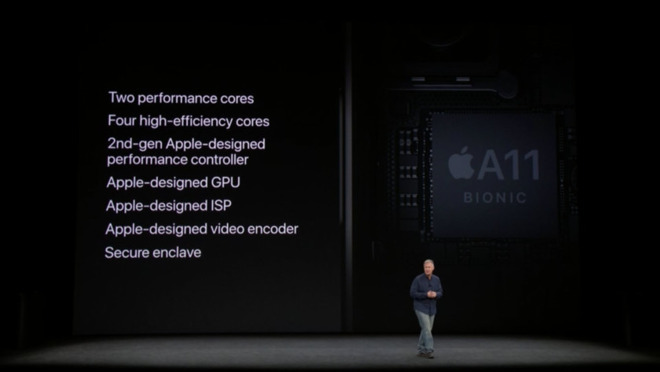In a move that would follow Apple's usual strategy, it's expected that new iPad Pros due in 2018 will feature a beefed up version of the A11 Bionic chip found in the iPhone 8 and iPhone X lineups, adding two more processing cores into the mix.
The current A11 Bionic features two performance cores and four high-efficiency cores, as well as an Apple-designed graphics processor. The same chip powers the iPhone 8, iPhone 8 Plus, and iPhone X, though the 8 is limited to 2GB of RAM while the 8 Plus and X have 3GB.
According to the latest rumor from MyDrivers, an "A11X" chip set to debut in next year's iPad Pro models will add two more cores, bringing the total to eight.
Three of those are said to be high-performance cores dubbed "Monsoon," while the five remaining energy-efficient cores are branded "Mistral."
In another potential change from the standard A11 Bionic, it was said that the "A11X" will boast a 7-nanometer manufacturing process from chipmaker Taiwan Semiconductor Manufacturing Co. In contrast, the iPhone X and iPhone 8 chips are made with a 10-nanometer process.
Apple's 2018 iPad Pro refresh is expected to ditch the home button for Face ID, just as the iPhone X has done. Accordingly, the "A11X" would likely include the same neural engine found on the iPhone X for quickly authenticating a user based on biometric facial recognition.
According to analyst Ming-Chi Kuo, the 2018 iPad Pro models will have greatly reduced bezels with the elimination of the home button, potentially allowing for smaller and lighter iPads. The devices are not, however, expected to feature costly OLED displays like the iPhone X, and will instead stick to LCD.
That means an edge-to-edge display is probably not in the cards — Â something that will help keep costs down with the large 10.5- and 12.9-inch iPads, but will also allow for a small bezel that would house the TrueDepth camera. In other words, the 2018 iPad Pros are not expected to feature a camera notch like the iPhone X.
 Neil Hughes
Neil Hughes








-m.jpg)






 Christine McKee
Christine McKee
 Wesley Hilliard
Wesley Hilliard
 Malcolm Owen
Malcolm Owen
 Andrew Orr
Andrew Orr
 William Gallagher
William Gallagher
 Sponsored Content
Sponsored Content









38 Comments
Wow. Sure would love to see that in a Mac
Face ID will be across all iDevices. As of now current LCD on iPads is fine until OLED prices go way down. I rather have thin bezel than so called edge to edge screen. Usability, no difference.
I’m still coming to grips with so many hi efficiency cores. So now they will be going to 5? I thought the point to that was to use less processing performance when the device wasn’t doing anything stressful. So reading a book would just use a low power core, or maybe two. The GPU also goes into 30FP/s, or slower mode, until you turn a page.
so why have so many of them? I get what Apple is apparently doing with them technically, as far as their abilities go, but I can’t help but think that an additional performance core, with fewer efficiency cores would be better. I suppose Apple is doing things with the OS that makes this worthwhile. But it does seem odd that they would raise the performance of the hi performance cores by 30%, and the performance of even more hi efficiency cores by 70%.